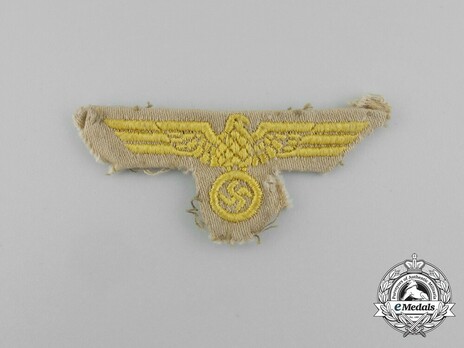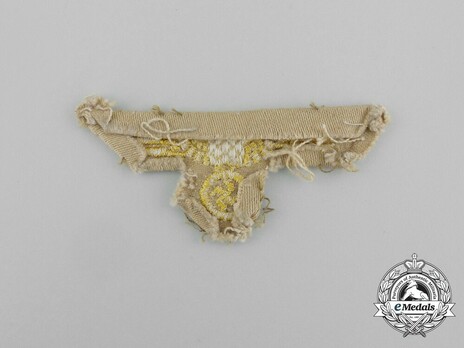Kriegsmarine Gold On Brown Cloth Cap Eagle Insignia
SKU: 21.GOR.03.01.01.02.003
Estimated market value:


Estimated market value:
Attributes
History
The national emblem worn on Kriegsmarine headgear comes in two main designs, the gold-coloured Wehrmachtsadler (eagle with outstretched wings clutching a Hakenkreuz/swastika in a wreath), and the Wehrmacht eagle. The Wehrmacht eagle was only worn on steel and pith helmets, and fore-and-aft hats.
The Wehrmachtsadler national emblems are made from metal or woven/embroidered. The metal national emblems feature either a vertical needle/pin or prongs on the reverse.
The 1st pattern of the Wehrmachtsadler national emblem was only made from metal. From August 1934 until early 1935, the emblems were made from neusilber gilt. In the beginning of 1935, the composition was changed to lightweight gilt metals or aluminum gilt. The 1st pattern emblems have shorter wings, and are noticeably smaller and flatter than the 2nd pattern emblems.
In April 1935, the 2nd pattern of the Wehrmachtsadler national emblem was introduced, with woven/embroidered versions alongside the metal version. The 2nd pattern metal emblems are primarily composed of stamped brass or light metal-alloys, which were silvered (with aluminum coating) or gilded, for Administrative Officials or Officers and enlisted men, respectively. Beginning in 1936, the metal emblems were produced as a single piece with the national cockade for wear on the Sailor's Cap and the Field-Grey Uniform Visor Field Cap; this increased the height measurement from 20mm to 40mm. The 2nd pattern woven/embroidered emblems were meant to immediately replace the metal emblems, but this replacement was never fully accomplished. The metal emblems continued to be worn on the blue and white Kriegsmarine headgear, even in conjunction with embroidered cockade and wreath insignia.
The regulations governing the manufacture of the woven/embroidered emblems stated that they were to be hand-embroidered, but as a result of the wartime demand, they were also machine-woven and machine-embroidered. The colour of the thread was yellow for all ranks, with the only exception being Administrative Officials who had their emblems made with silver/white thread. There are also rare examples of the national emblems worn by low-ranking NCOs and enlisted men/troops using cornflower-blue thread. The thread was generally made from cotton or artificial silk, but for Officers the thread could be made from gilt bullion or yellow celleon thread, and silver/aluminum bullion for Administrative Officials with the rank of Officer.
The woven/embroidered insignia were manufactured on backing whose colour corresponded with the headgear on which they were worn: blue backing for the blue and white uniform, field-grey or blue tinted dark-green backing for the field-grey uniform, and tan/khaki or, rarely, blue backing for the tropical uniform. On rarer occasions, blue emblems on a white backing were used for the white uniform as well.
The only difference between the Heer Wehrmachtsadler and the 1st pattern Kriegsmarine Wehrmachtsadler (national emblem) is the colour, the Heer emblem is silver-coloured while the Kriegsmarine emblem is gold-coloured.
The Wehrmacht eagle national emblem was painted onto the steel helmets, or made from stamped brass for the pith helmets.
The size of the embroidered and metal emblems varied by manufacturer, pattern, and type of headgear on which it was worn.


Comments
Sign in to comment and reply.


Scroll Top